
Home
Preamble
Index
Areas
Map
References
Me
Drakkar
Saunterings: Walking in North-West England
Saunterings is a set of reflections based upon walks around the counties of Cumbria, Lancashire and
North Yorkshire in North-West England
(as defined in the Preamble).
Here is a list of all Saunterings so far.
If you'd like to give a comment, correction or update (all are very welcome) or to
be notified by email when a new item is posted - please send an email to johnselfdrakkar@gmail.com.
163. Baugh Fell and Alpacas
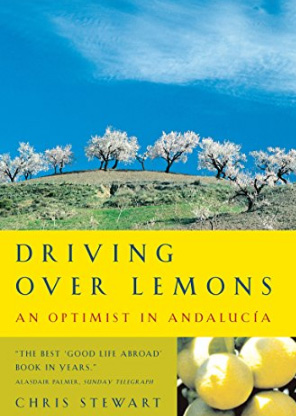
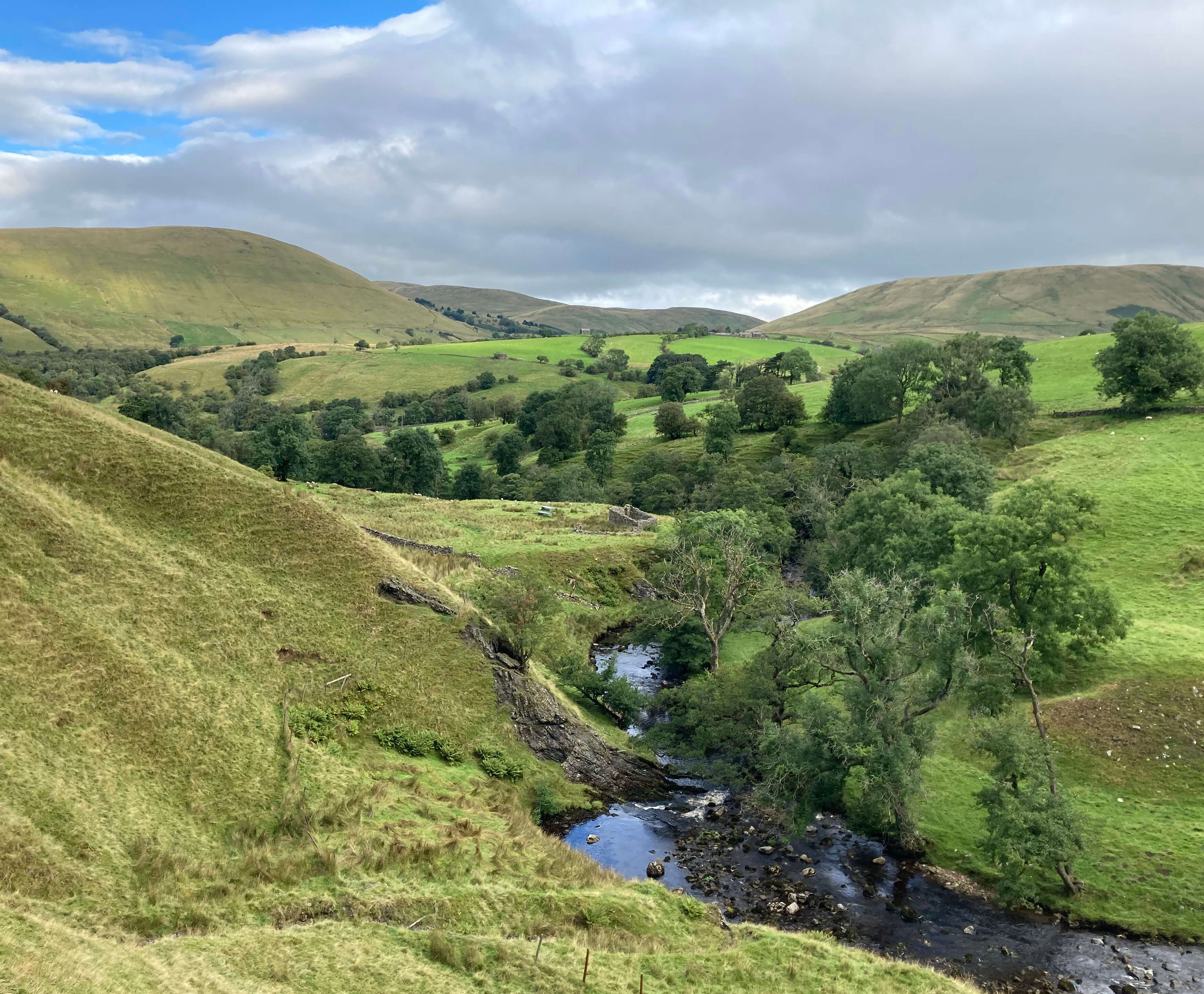 I was reading Driving over Lemons (Stewart, 1999), an account of an Andalucian adventure, when
on page 210 I found the author “vomiting violently into the rosebushes”. His wife helpfully reads a quote to
him: “it’s a wonder that man is so concerned to stop vomiting which is a natural and wholesome
purge for all the ills of the body”. To which the response is “BAAUUUGGHHH!”
I was reading Driving over Lemons (Stewart, 1999), an account of an Andalucian adventure, when
on page 210 I found the author “vomiting violently into the rosebushes”. His wife helpfully reads a quote to
him: “it’s a wonder that man is so concerned to stop vomiting which is a natural and wholesome
purge for all the ills of the body”. To which the response is “BAAUUUGGHHH!”
I never knew that the name of Baugh Fell was intended to simulate violent vomiting. I thought
it was pronounced Bo Fell, a sweet name like Bo Peep. I suspected that locals said Bofl, with the
stress on the Bo and with the ‘Fell’ collapsed, as it is with other Fells, and sensibly so because
it is the first part of the name that distinguishes any fl from other fls. Sedgwick (1868) said
that locals pronounced it with a guttural sound. Bughfl perhaps. Or Bawful. Some call it Bog Fell,
to emphasise that it is a damp, dreary hill. I am sure that Baugh never rhymes with laugh although,
come to think of it, barf is a slang word for vomit. There are not many laughs to be had on Baugh
Fell. It requires a serious commitment to tackle it.
Well, it would if you were to tackle the whole sprawling mass, with, to the east, a number
of scruffy tarns within a wet, peaty wilderness and, to the west, a weather-beaten, barren terrain
of little interest. However, the lower slopes of Baugh Fell are not bad at all. To the east
there’s the appealing, hidden limestone valley of Grisedale, visited in
Sauntering 13.
To the north and south are Uldale and Garsdale, respectively, and
to the west the slopes afford a magnificent view across Rawtheydale to the rolling eastern Howgills.
I took the opportunity to be tipped out at Rawthey Bridge on the A683, some five miles
north of Sedbergh. Here the River Rawthey emerges from Rawthey Gill (shown top right) to begin to live
up to its status as a river. I headed up the valley intending to look at the series of waterfalls
but after a mile or so I changed my mind and headed south on the broad expanse of Baugh Fell
slopes. This is an isolated, anonymous plateau with nothing marked on the map apart from the
becks flowing westward. It is not easy going. There are no paths and the terrain is of rough
grass and heather, with occasional boggy patches and gills to dip in and out of.
Scenically, though, the highlight of this walk is the view to the west of the Howgill fells, from Winder to Harter Fell. There were occasional sunny patches gliding over the hills but most of the time the hills were under low cloud, rendering them an ominous black. I could not make out the waterfall of Cautley Spout at all. To the east, the brooding slopes of a dark Baugh Fell loomed above me.
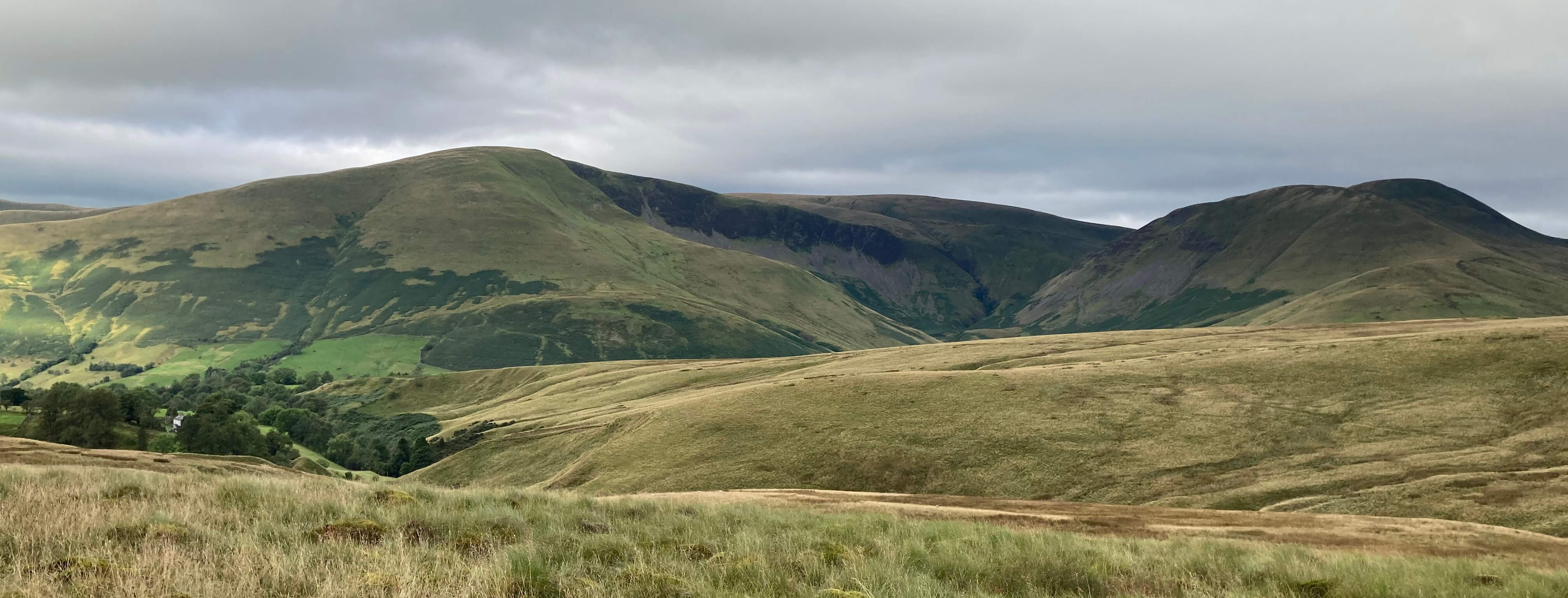
Looking to the Howgills, Cautley Crag in the middle, with Cautley Spout (not visible to me)
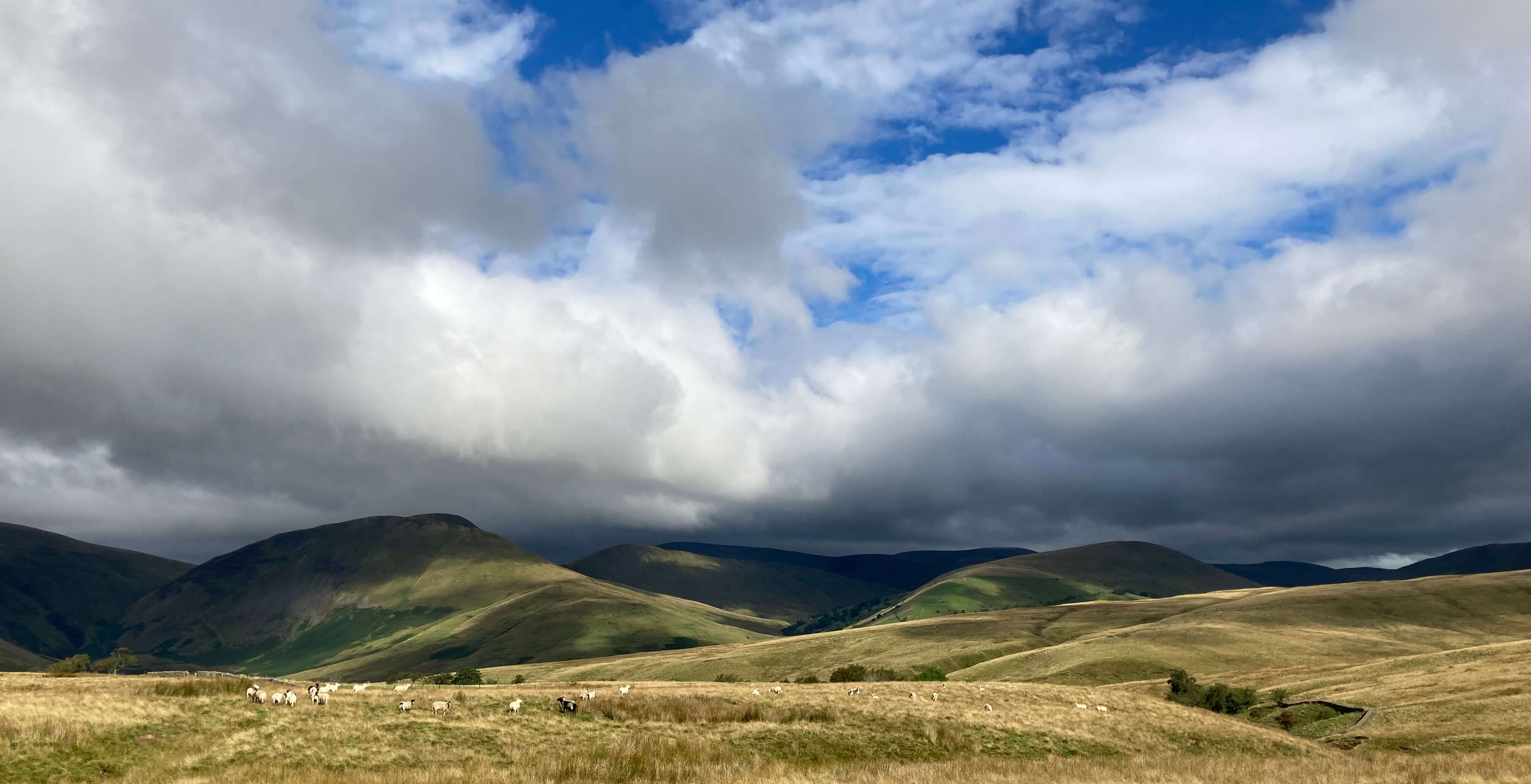
The Howgills from further on, with clouds
There are also some large shake-holes to be avoided. These, and the series of waterfalls in
Rawthey Gill, are a clue that despite the dull appearance there is some interesting geology
underfoot. There are no shake-holes on the slopes of the Howgills on the other side of the A683.
The shake-holes here indicate that there’s limestone below, although there is little of it to see
on the moor. I was, in fact, walking along the line of the Dent Fault, mentioned in
Sauntering 95.
This fault has caused rock contortions that are revealed in some of the gills, in particular in
Taythes Gill, which I approached next. Taythes Gill is a rather fine ravine, tucked away and rarely visited.
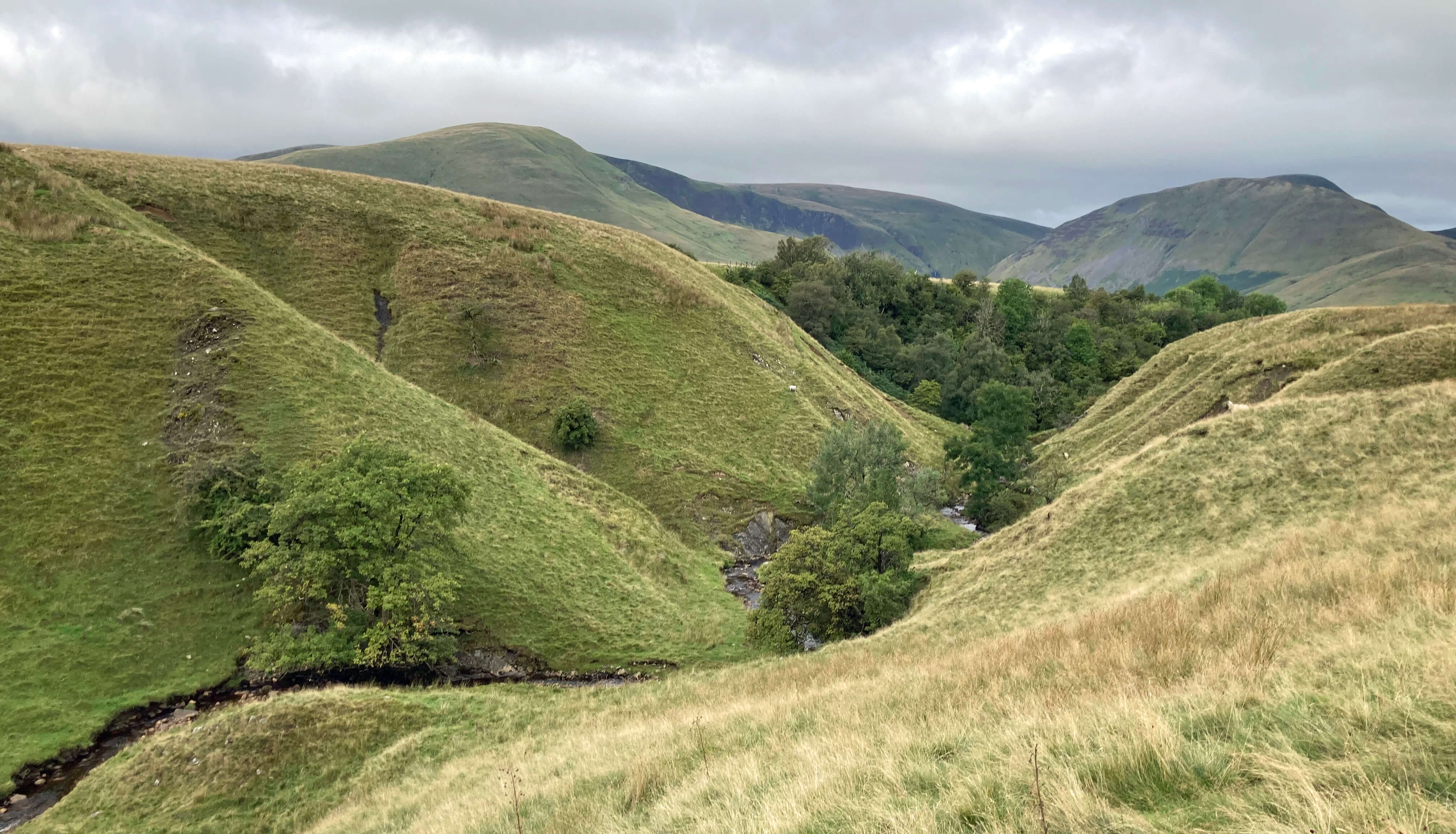
Taythes Gill
Further along, a few 'Pit (dis)'s are marked on the map. I saw no sign of them but there are various sunken
tracks across the moor that may have been created when the pits were active. They are, of course,
not walkers’ tracks although they may easily lead a walker astray. Not concentrating, I reached Marsh
Gate before realising I was on the wrong bridleway. So I backtracked to continue south to find the
desired path, the one over High Pasture, which it is. This passes Hebblethwaite Hall, which is
on the site of one of the oldest halls in the region, Hebblethwaite (or Hebletwayt) being an ancient
name for the district.
The path continues past Ghyllas, a farm which in 2000 began a
Why Not Alpacas? campaign.
Alpacas are not so uncommon in our countryside nowadays so perhaps the campaign has had an effect.
Anyway, it is good to see these cute animals in our fields and if you are content to see a photo of
them then you need read no further. But alpacas give me sleepless nights, so if you want to know
why, buckle up and read on.
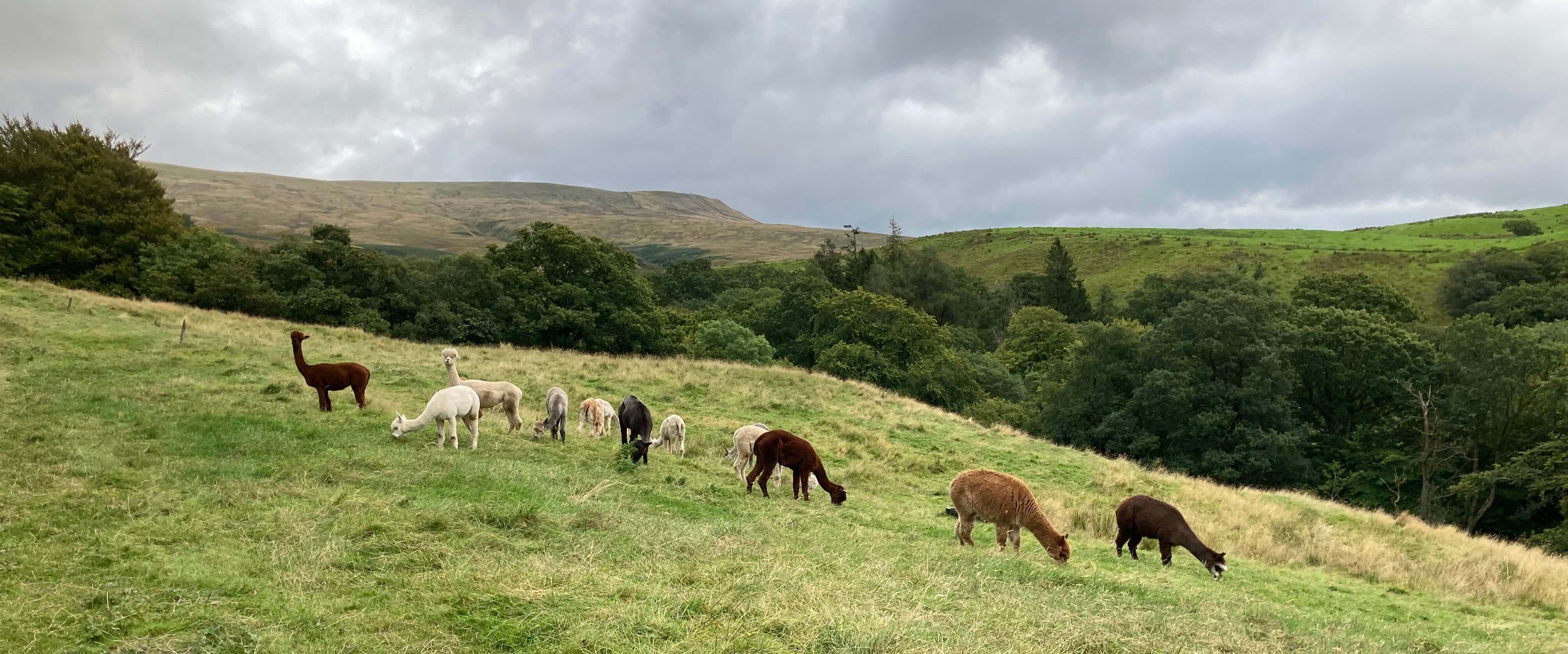
Alpaca near Hebblethwaite Hall, with Baugh Fell in the distance
There are seven camelids, that is, members of the family Camelidae. There are three camels and four
species from South America, the alpaca, llama, vicuña and guanaco, the first two of these being
domesticated forms of the last two. These four species can interbreed to produce fertile offspring.
For example, a male llama and a female alpaca produce a haurizo. Can these hybrids interbreed
with the original four and other hybrids? If so, are those further hybrids fertile? And can they
interbreed, and so on?
Why are the four considered to be species but not the huarizo and other hybrids? And
do domesticated animals count as distinct species? According to
Wikipedia, "In 2003, the International Commission
on Zoological Nomenclature ruled that the domestic cat
is a distinct species ... In 2007, it was considered a subspecies of the European wildcat ...
In 2017, the IUCN Cat Classification Taskforce followed the recommendation of the ICZN in
regarding the domestic cat as a distinct species." So illustrious committees can't
make up their minds about the cat, never mind the alpaca and llama.
I need to backtrack to consider what a ‘species’ is. Noah knew. He took two of each species onto
his ark. Unfortunately, he didn’t have the time to tell us what he knew. Carl Linnaeus (1707-1778)
tried to be rigorous about the notion of ‘species’, by listing
them all and giving them Latin names. At that time, there was no theory of evolution and
species were considered to be immutable. Listing species was like listing stars.
How did Linnaeus decide what constituted a species? I doubt that he was explicit about
that but I assume that he relied first on appearance. It is obvious that an elephant is different
from a tiger. But what about the hippo and the pygmy hippo? And the black rhino
and white rhino? I think I can distinguish an alpaca from a
llama (the former is smaller, has pointed, not curved, ears, and has soft, not coarse, fleece,
although I don't suppose that that is sufficient reason to separate them into different species).
I couldn't tell an alpaca from a vicuña or guanaco, judging from photographs. They
seem more similar than, say, a poodle and a pug, both within the dog species (if it is a species).
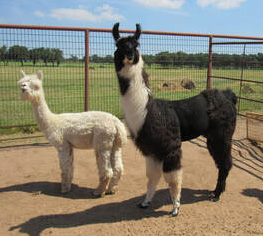 The theory of evolution made it clear that the attempt to define a fixed set of species was
misguided. Species changed, albeit over long periods of time. The focus moved more to how species
evolved and therefore to the role of reproduction. An attempt was made to define a species as
comprising members that can reproduce with one another to generate further members of the same
species. Of course, that definition doesn’t help at all with asexual organisms, such as fungi.
In any case, various members of apparently different species can interbreed,
not least our four camelids. Darwin himself was fascinated by zebroids, that is, hybrids of
zebra and various species of horse.
Infertile hybrids were disqualified from species status, which rules out the
mule, for example, but not the huarizo.
The theory of evolution made it clear that the attempt to define a fixed set of species was
misguided. Species changed, albeit over long periods of time. The focus moved more to how species
evolved and therefore to the role of reproduction. An attempt was made to define a species as
comprising members that can reproduce with one another to generate further members of the same
species. Of course, that definition doesn’t help at all with asexual organisms, such as fungi.
In any case, various members of apparently different species can interbreed,
not least our four camelids. Darwin himself was fascinated by zebroids, that is, hybrids of
zebra and various species of horse.
Infertile hybrids were disqualified from species status, which rules out the
mule, for example, but not the huarizo.
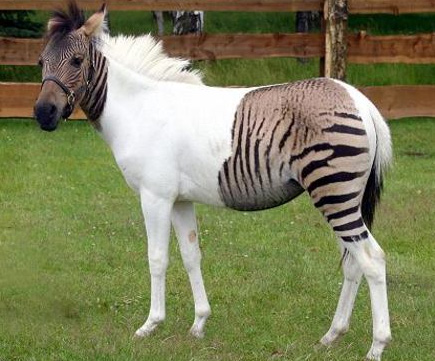 But how can anyone tell if this animal can
interbreed with that animal, especially for those many species that are now extinct? Is it
a kind of ‘in principle’ reproduction? From my limited experience, ‘in principle’ reproduction is
not the same as ‘in practice’ reproduction.
But how can anyone tell if this animal can
interbreed with that animal, especially for those many species that are now extinct? Is it
a kind of ‘in principle’ reproduction? From my limited experience, ‘in principle’ reproduction is
not the same as ‘in practice’ reproduction.
I hope that experts can allay my naive thoughts.
We wouldn't want the whole taxonomic edifice of genus, family, order, class, phylum and kingdom
to collapse because they couldn't define the foundational concept of species.
I suppose we could still go on about protecting
‘endangered species’, hoping that nobody asks us what a species is.
Perhaps help is on the way from modern gene analysis. It has already shown us that
the alpaca is descended from the vicuña rather than the guanaco, as previously thought. This
has led to a change in Latin name but no realignment of species. We are familiar with
statements such as that we share, say, 98% of our genes with the mouse. So, we conclude,
the important genes lie in the 2%, the ones that make us different. But who are we to decide
which genes are important? A flea probably doesn’t care about that 2%. We
can be sure that the differences that gene analysis detects will not correspond to those
that we have used to define species. The
giraffe,
which since Linnaeus has been considered to be one
species, may, in fact, according to gene analysis, be of three, four, six, eight … (take your pick)
distinct species. They don’t look very different to me!
Maybe gene analysis will provide a precise scientific basis for partitioning organisms
into distinct sets, called species. Or perhaps it will show that the endeavour to develop such
precision is futile – that all organisms are as one, with variously overlapping genes. Which might be
a beneficial outcome.
I walked on, over Straight Bridge, which is on a bend, to New
Bridge, which is old, and into Sedbergh.
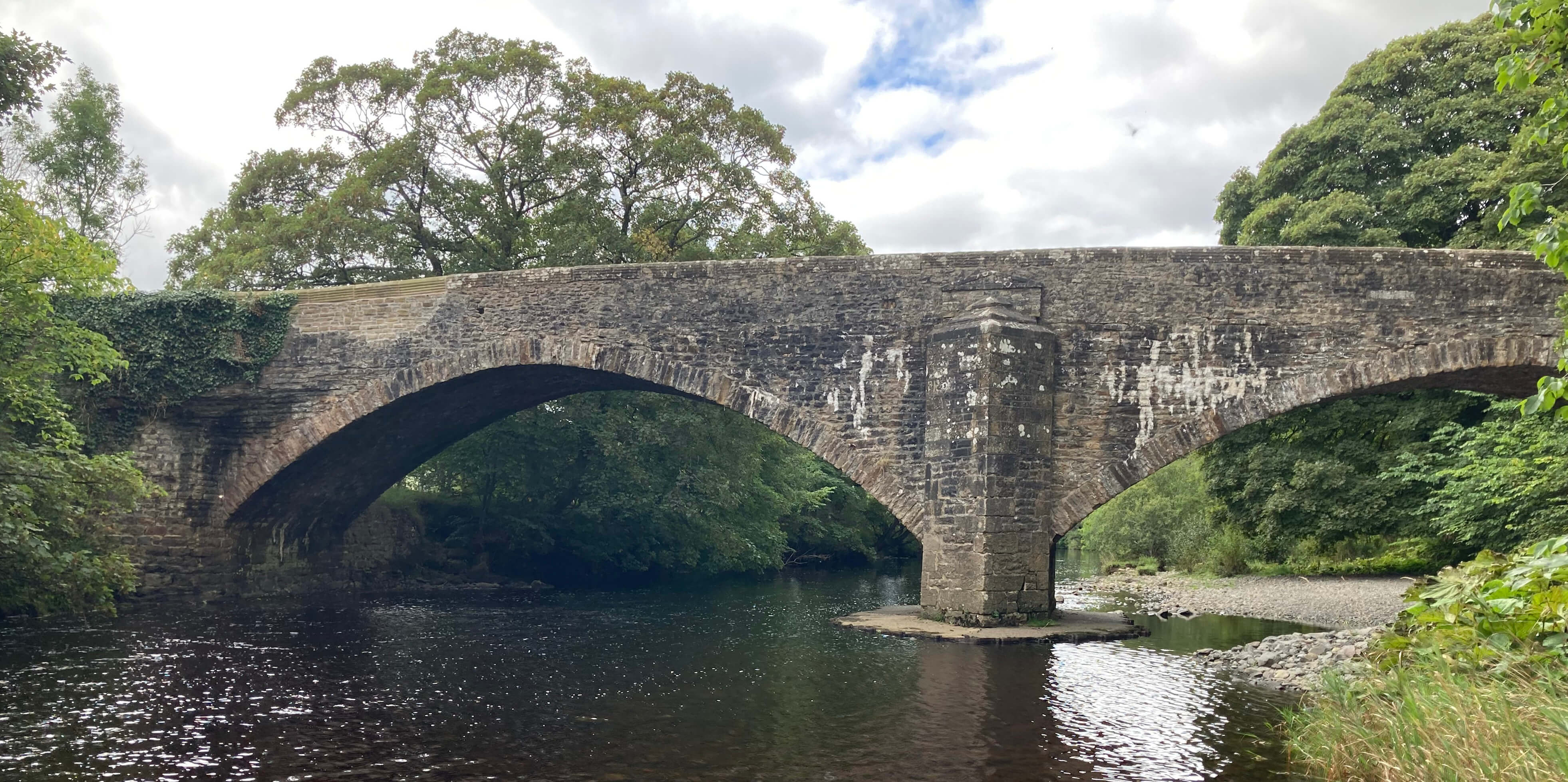
New Bridge, Sedbergh
Date: September 10th 2022
Start: SD713978, Rawthey Bridge (Map: OL19)
Route: (linear) SE by Rawthey, S – Taythes Gill –
(by mistake, SW – Marsh Gate – back over Whinny Gill)
– SW past Hebblethwaite Hall – Straight Bridge – SW by Rawthey – Sedbergh.
Distance: 7 miles; Ascent: 150 metres
Home
Preamble
Index
Areas
Map
References
Me
Drakkar
© John Self, Drakkar Press, 2018-

Top photo: The western Howgills from Dillicar;
Bottom photo: Blencathra from Great Mell Fell



 I was reading Driving over Lemons (Stewart, 1999), an account of an Andalucian adventure, when
on page 210 I found the author “vomiting violently into the rosebushes”. His wife helpfully reads a quote to
him: “it’s a wonder that man is so concerned to stop vomiting which is a natural and wholesome
purge for all the ills of the body”. To which the response is “BAAUUUGGHHH!”
I was reading Driving over Lemons (Stewart, 1999), an account of an Andalucian adventure, when
on page 210 I found the author “vomiting violently into the rosebushes”. His wife helpfully reads a quote to
him: “it’s a wonder that man is so concerned to stop vomiting which is a natural and wholesome
purge for all the ills of the body”. To which the response is “BAAUUUGGHHH!”




 The theory of evolution made it clear that the attempt to define a fixed set of species was
misguided. Species changed, albeit over long periods of time. The focus moved more to how species
evolved and therefore to the role of reproduction. An attempt was made to define a species as
comprising members that can reproduce with one another to generate further members of the same
species. Of course, that definition doesn’t help at all with asexual organisms, such as fungi.
In any case, various members of apparently different species can interbreed,
not least our four camelids. Darwin himself was fascinated by zebroids, that is, hybrids of
zebra and various species of horse.
Infertile hybrids were disqualified from species status, which rules out the
mule, for example, but not the huarizo.
The theory of evolution made it clear that the attempt to define a fixed set of species was
misguided. Species changed, albeit over long periods of time. The focus moved more to how species
evolved and therefore to the role of reproduction. An attempt was made to define a species as
comprising members that can reproduce with one another to generate further members of the same
species. Of course, that definition doesn’t help at all with asexual organisms, such as fungi.
In any case, various members of apparently different species can interbreed,
not least our four camelids. Darwin himself was fascinated by zebroids, that is, hybrids of
zebra and various species of horse.
Infertile hybrids were disqualified from species status, which rules out the
mule, for example, but not the huarizo.
 But how can anyone tell if this animal can
interbreed with that animal, especially for those many species that are now extinct? Is it
a kind of ‘in principle’ reproduction? From my limited experience, ‘in principle’ reproduction is
not the same as ‘in practice’ reproduction.
But how can anyone tell if this animal can
interbreed with that animal, especially for those many species that are now extinct? Is it
a kind of ‘in principle’ reproduction? From my limited experience, ‘in principle’ reproduction is
not the same as ‘in practice’ reproduction.

